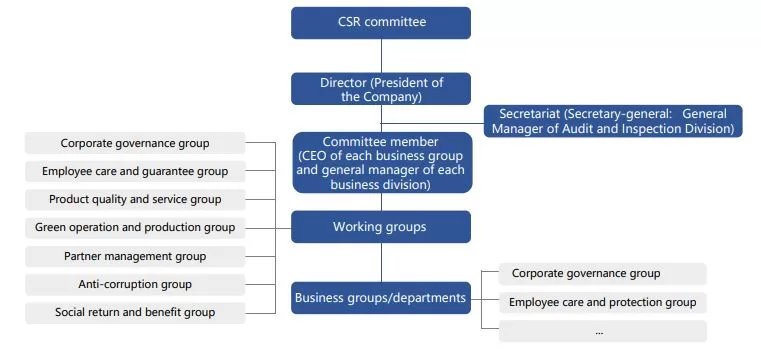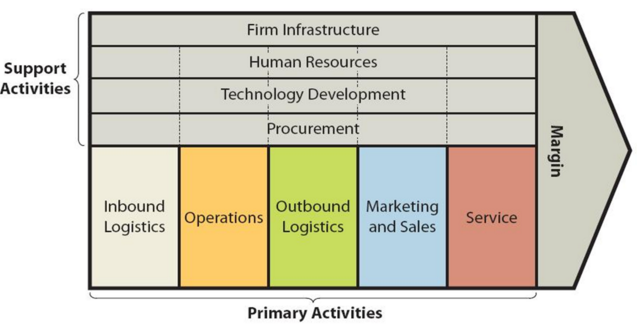Search results for: Mckinsey 7s
BYD Company Limited Report contains the application of the major analytical strategic frameworks in business studies such as SWOT, PESTEL, Porter’s Five Forces, Value Chain analysis, Ansoff Matrix and McKinsey 7S Model on BYD. Moreover, the report contains analyses of BYD’s business strategy, leadership and organizational structure and ecosystem. The report also analysis marketing strategy, ecosystem and discusses the issues of corporate social responsibility.
Marriott International Inc. Report contains the application of the major analytical strategic frameworks in business studies such as SWOT, PESTEL, Porter’s Five Forces, Value Chain analysis, Ansoff Matrix and McKinsey 7S Model on Marriott. Moreover, the report contains analyses of Marriott’s business strategy, leadership and organizational structure and ecosystem. The report also analysis marketing strategy, ecosystem and discusses the issues of corporate social responsibility.
Founded in 1993 by Jensen Huang, Chris Malachowsky and Curtis Priem, Nvidia Corporation is the multinational technology company that aims to solve the world’s visual computing challenges. The GPU maker is the 7th largest company in the world with a market cap of around USD 1 trillion. For fiscal year 2022 the revenue was a record USD 26.91 billion, up 61 percent from USD 16.68 billion a year ago. Gross margins expanded to 64.9 percent, and earnings per share were USD 3.85, up 123 percent from a year ago (Annual Review, 2022)
Nvidia business strategy involves benefiting from the first mover advantage, prioritizing performance of products over their costs and pursuing vertical integration. The company’s co-founder and CEO of 30 years Jensen Huang is famous for his charismatic leadership style and his ability to inspire and motivate his team. The multinational technology company has functional and hybrid organizational structure and divides its business practices into various functions such as engineering and product development, supply chain and operations, human resources, finance and accounting and legal and compliance.
Nvidia organizational culture integrates the elements of innovation, intellectual honesty, high performance and inclusion and diversity. Within the framework of Ansoff Grow Matrix the company uses all four growth strategies – market penetration, product development, market development and diversification in an integrated manner.
The world’s most valuable semiconductor company possesses certain strengths such as global leadership in GPU market, unique position to benefit from the increasing popularity of artificial intelligence (AI) and more than 370 partnerships revolving around self-driving cars. Furthermore, Nvidia possesses advanced R&D capabilities and these allowed the company to reach its current state. At the same time, the software and fables company has serious weaknesses that need to be addressed. At the moment Nvidia depends on a single type of product i.e. graphics cards as the main source of profit. Also due to its pursuit of fabless manufacturing strategy, the company is heavily dependent on 3rd parties to fulfil its obligations in front of its customers.
Nvidia Corporation Report contains the application of the major analytical strategic frameworks in business studies such as SWOT, PESTEL, Porter’s Five Forces, Value Chain analysis, Ansoff Matrix and McKinsey 7S Model on Nvidia. Moreover, the report contains analyses of Nvidia’s business strategy, leadership and organizational structure and ecosystem. The report also analysis marketing strategy, ecosystem and discusses the issues of corporate social responsibility.
Founded in 2010 in Manhattan USA by Adam Neumann and Miguel McKelvey, WeWork Inc. is a global flexible workspace provider that comprises a network of 756 locations in 38 countries. The co-working giant has approximately 590 thousand physical memberships as of December 2021 (Annual Report, 2021). In the US in 2021 WeWork represented approximately 0.5% of all commercial office space and 63% of Fortune 100 companies are WeWork members[1]
WeWork’s mission is to empower tomorrow’s world at work. The workspace provider has a business strategy of digitalizing the real estate business and offering space as a service. The company had severe leadership and ethical challenges under controversial co-founder and the first CEO Adam Neumann, but the current CEO Sandeep Mathrani is bringing discipline and maturity to the leadership. The hierarchical organizational structure of the company has allowed Mathrani to turn around the business to a certain extend via reducing operational costs and focusing on the core business.
The co-working and office space operator has considerable strengths such as solid international presence, brand recognition and experience in its niche. At the same time, WeWork has certain serious weaknesses that include the absence of profitability and high level of indebtedness. Moreover, WeWork brand image has been severely damaged due to management and ethical issues under the leadership of Adam Neumann as discussed throughout this report.
WeWork Inc. Report contains the application of the major analytical strategic frameworks in business studies such as SWOT, PESTEL, Porter’s Five Forces, Value Chain analysis, Ansoff Matrix and McKinsey 7S Model on WeWork. Moreover, the report contains analyses of WeWork’s business strategy, leadership and organizational structure and ecosystem. The report also analysis marketing strategy, ecosystem and discusses the issues of corporate social responsibility.
IKEA Group Report contains the application of the major analytical strategic frameworks in business studies such as SWOT, PESTEL, Porter’s Five Forces, Value Chain analysis, Ansoff Matrix and McKinsey 7S Model on IKEA. Moreover, the report contains analyses of IKEA’s business strategy, leadership and organizational structure and ecosystem. The report also analysis marketing strategy, ecosystem and discusses the issues of corporate social responsibility.
Apple Inc. Report contains the application of the major analytical strategic frameworks in business studies such as SWOT, PESTEL, Porter’s Five Forces, Value Chain analysis, Ansoff Matrix and McKinsey 7S Model on Apple. Moreover, the report contains analyses of Apple’s business strategy, leadership and organizational structure and ecosystem. The report also analysis marketing strategy, ecosystem and discusses the issues of corporate social responsibility.
Starbucks Corporation Report contains the application of the major analytical strategic frameworks in business studies such as SWOT, PESTEL, Porter’s Five Forces, Value Chain analysis, Ansoff Matrix and McKinsey 7S Model on Starbucks. Moreover, the report contains analyses of Starbucks business strategy, leadership and organizational structure and ecosystem. The report also analysis marketing strategy, ecosystem and discusses the issues of corporate social responsibility.
Amazon.com Inc. was founded in 1994 in Washington and Amazon.com as a website became first active in July 1995 to become the largest online retailer in the world to offer Earth’s Biggest Selection in less than two decades. The e-commerce and cloud computing company generated revenues of USD 386 billion and earned a net income of USD 21.3 billion in 2020 alone.[1]
The e-commerce giant employs approximately 1,3 million full-time and part-time employees referred to as Amazonians.[2] Amazon has declared its adherence to four principles: customer obsession rather than competitor focus, passion for invention, commitment to operational excellence and long-term thinking. These principles represent sources of Amazon’s competitive advantage.
Amazon business strategy is a hybrid of cost leadership and business diversification. The online retailer also benefits from encouraging communication between various elements within its ecosystem and promotion of its leadership principles consisting of 16 points discussed in this report. The founder and former CEO Jeff Bezos prefers to base business strategy on things that do not change. Specifically, consumers will always want low prices, variety and speedy delivery of their orders. Amazon focuses on these facts via effective integration of information technology into various business processes.
Combination of pragmatist, visionary and autocratic leadership styles are exercised at various levels at Amazon. The company has a hierarchical organizational structure. Nevertheless, it remains highly flexible to adapt to frequent changes in the external marketplace. Amazon organizational culture, on the other hand, is based on the principles of high level of cost-consciousness, constant reinvention and improvement of organizational culture and customer obsession.
Major weaknesses associated with Amazon include seasonality of the business, low profit margins and lack of focus on specific product or service categories. Moreover, a weak competitive position of Amazon’s Fire Phone and damage to the brand image due to tax avoidance scandal in the UK can be listed as weaknesses of Amazon. Furthermore, harsh working conditions for warehouse employees is a noteworthy weakness for the tech giant.
Amazon.com Inc. Report contains the application of the major analytical strategic frameworks in business studies such as SWOT, PESTEL, Porter’s Five Forces, Value Chain analysis, Ansoff Matrix and McKinsey 7S Model on Amazon. Moreover, the report contains analyses of Amazon business strategy, leadership and organizational structure and ecosystem. The report also analysis marketing strategy, ecosystem and discusses the issues of corporate social responsibility.

In today’s socially conscious world, consumers increasingly associate their purchases with values. BYD’s commitment to environmental sustainability, ethical labour practices, and community engagement resonates with eco-conscious buyers, fostering trust and brand loyalty. This translates to positive word-of-mouth, enhanced brand image, and ultimately, increased sales. BYD received a range of accolades for its CSR efforts such as such as the Zayed Sustainability Prize, the UN Powering the Future We Want Energy Grant, and featuring on Fortune magazine’s “Companies that Change the World” list.[1] CSR Organization of BYD BYD Supporting Local Communities BYD Charity Foundation donated a total of RMB240 million to charities in 2022 alone The company contributed over RMB59.1 million worth of epidemic prevention and control fundings and supplies in 2022 and donated RMB5 million to Luding County, Sichuan Province for emergency relief and post-disaste Waste Reduction and Recycling by BYD The electric automaker has gradually replaced the cartons, wooden packaging boxes and iron frames used in the transportation of battery pack products with the recyclable blister box with a service life cycle of more than 3 years and an annual recycling cycle of over 900 times, greatly reducing resource consumption Carbon Emissions by BYD In 2022, BYD was the first manufacturer in the world suspended the production of fuel-engine vehicle and build the first zero-carbon headquarters of automobile brand in China[2] The EV giant has established a green traffic system by popularizing EVs to control pollution and launching the SkyShuttle to relieve traffic jam The company claims that until October 11, 2022, it has avoided the emission of 14,672,117,797 kg of carbon.[3] BYD and Sustainable Sourcing Suppliers are required to ensure that they do not use any form of forced labour, bonded labour (including debt mortgage) or indentured labour. They shall not use child labour…

BYD value chain analysis is an analytical framework that assists in identifying business activities that can create value and competitive advantage to the business. Figure below illustrates the essence of BYD value chain analysis. BYD Primary Activities BYD Inbound logistics BYD inbound logistics is one of the key sources for value creation for the EV behemoth. BYD has more than 11,000 cooperative suppliers, 41% of which are located in Southern China, 34% in Eastern China, 9% in Northern China.[1] The electric automaker aims to produce as many spare parts in-house as possible, thus decreasing dependence on external vendors, at the same time increasing profit margins. For example, for BYD Dolphin only tyres and windows are delivered by suppliers and all other components are produced by the company itself.[2] BYD prioritizes long-term partnerships with reliable suppliers, securing stable access to critical materials and components like lithium, cobalt, and semiconductors. This reduces procurement risks and price fluctuations. The company leverages cutting-edge technologies like digital supply chain management systems, artificial intelligence for demand forecasting, and automated warehouse robots. BYD Operations In the operations stage, BYD engages in the manufacturing and assembly of its products. This includes the production of EVs, batteries, solar panels, and energy storage systems. Efficient production processes and quality control measures are crucial in this stage. BYD operations can be divided into the following four segments. Automobile. BYD delivered a total of 1,802,000 vehicles in 2022, with a year-on- year growth of 149.9%, including around 1,788,000 new energy vehicles, with a year-on-year growth of 217,6%.[3] Rail Transit. The company produces medium-capacity “SkyRail” and low-capacity “SkyShuttle” filling the technological and industrial gap in rail transit and providing effective solutions to traffic jams in cities all over the world. Renewable energy. As a provider of integrated renewable energy solutions, BYD produces relevant products like batteries, solar energy…
